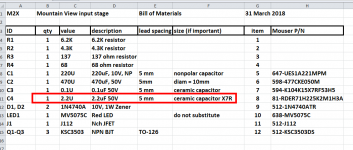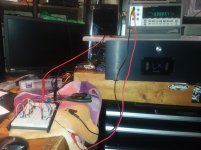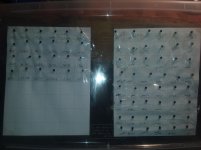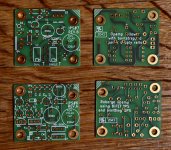Either one will work; nonpolar/polarized are both good. You might have some 2.2uF CERAMIC caps lying around from previous IPS daughter card builds; those would be fine too. In this circuit the caps are just bypass & smoothers. It's a DC circuit and they're not working very hard.
It takes an extra 2 seconds to edit the schematic and change the displayed symbol from one to the other. I needed those 2 seconds for other purposes.
Here is what I attached to post #3377 ; click to remove the image distortion
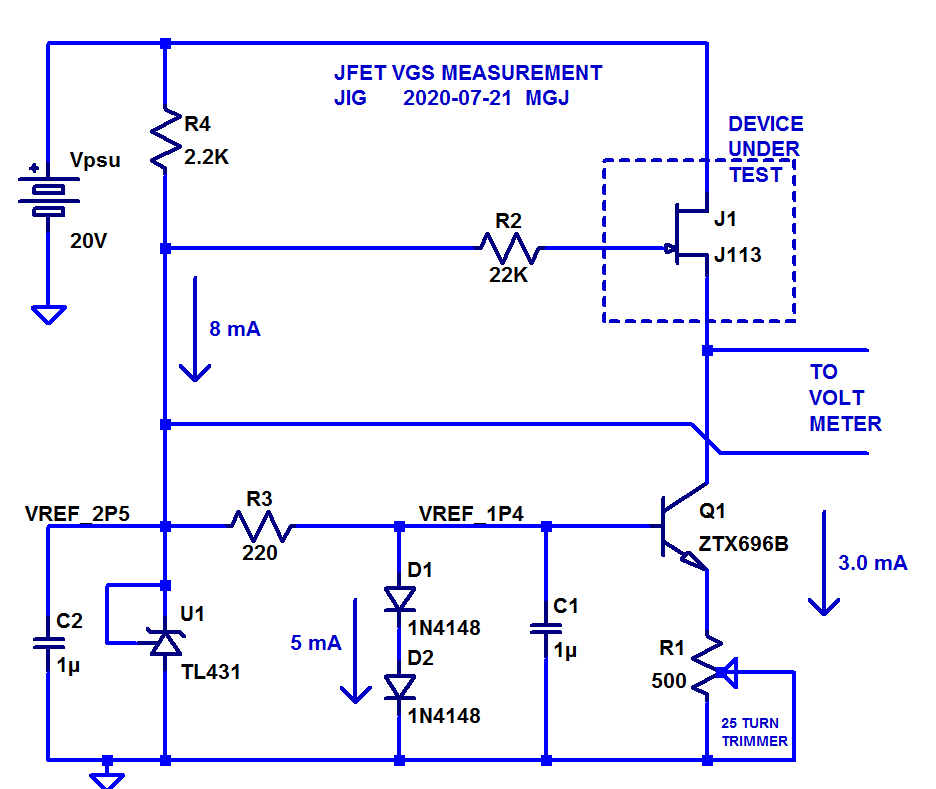
Please feel free to decide what "matched" means, TO YOU, and assemble whatever test jig you like, in order to discover "matches". Just because I happen to be looking for pairs of J113s whose VGS's are identical when Idrain=3mA , doesn't mean you have to! In fact most of the JFET matching jigs I've seen here on diyAudio, aim at a different target. More than one different target in fact.
It takes an extra 2 seconds to edit the schematic and change the displayed symbol from one to the other. I needed those 2 seconds for other purposes.
Here is what I attached to post #3377 ; click to remove the image distortion
Please feel free to decide what "matched" means, TO YOU, and assemble whatever test jig you like, in order to discover "matches". Just because I happen to be looking for pairs of J113s whose VGS's are identical when Idrain=3mA , doesn't mean you have to! In fact most of the JFET matching jigs I've seen here on diyAudio, aim at a different target. More than one different target in fact.
Last edited:
I got the boards from Mark today (Thanks buddy!) and boarded the jig. I ran through 72 of the 100 J113s, before my butt went numb and my patients ran out. I haven't pulled my pairs yet, or really looked them over, but I'd say that the spread was very much like what Mark was seeing... mine seemed to be a bit tighter than some of his, but overall I'd say well worth the effort.
Here's the jig and some of the parts.
Here's the jig and some of the parts.
Attachments
Last edited:
I got the boards from Mark today (Thanks buddy!) and boarded the jig. I ran through 72 of the 100 J113s, before my butt went numb and my patients ran out. I haven't pulled my pairs yet, or really looked them over, but I'd say that the spread was very much like what Mark was seeing... mine seemed to be a bit tighter than some of his, but overall I'd say well worth the effort.
Here's the jig and some of the parts.
these are most definitely NOT japanese fets but don't let perfect be the enemy of good enough. There are a few pairs in there.
I also got ON Semi (Fairchild) J113. They are Made in China.
Can you get Japanese made J113?
I got them at RS Components and as long as they comply to the Datasheet it should be OK?
https://docs.rs-online.com/7eca/0900766b813f4fb0.pdf
Can you get Japanese made J113?
I got them at RS Components and as long as they comply to the Datasheet it should be OK?
https://docs.rs-online.com/7eca/0900766b813f4fb0.pdf
Ya thanks Mark, I glanced over them for a couple minutes and also found Row 6 column 5-6 at 0.64 mV
@grataku These are ON Semi from Mouser.
My comment was general about how well matched were japanese fets vs ...others
I find it interesting that all of you really experienced DIYers are willing to scan pages of numbers to find a match. I find that very challenging. I just sorted the values in ascending order with Excel. To belabor the obvious, each adjacent pair taken stepwise is the closest match. As Mark has said, how many matched pairs you have depends on what you define as a match. I hope someone tries pairs with different matching criteria (eg 5mV,10 mV, 20 mV Etc). I'd like to know how close the matching needs to be to make an audible improvement.
It could also be interesting to know how close to the "full" trace curve one of the "matched" pairs are. It should be easy to test Vgs at other current settings using the test jig? .....maybe one pair is closer than other?
But if it will not improve performance then it may be just waste of time.....other than for technical interest.
But if it will not improve performance then it may be just waste of time.....other than for technical interest.
My comment was general about how well matched were japanese fets vs ...others
I understood... I have some Phillips on the way, I'll jig them and post those numbers too.
I find it interesting that all of you really experienced DIYers are willing to scan pages of numbers to find a match. I find that very challenging. I just sorted the values in ascending order with Excel. To belabor the obvious, each adjacent pair taken stepwise is the closest match. As Mark has said, how many matched pairs you have depends on what you define as a match. I hope someone tries pairs with different matching criteria (eg 5mV,10 mV, 20 mV Etc). I'd like to know how close the matching needs to be to make an audible improvement.
Bah, a logical approach which that is more likely to be as accurate as possible.... Phooey!
I find it interesting that all of you really experienced DIYers are willing to scan pages of numbers to find a match. I find that very challenging. I just sorted the values in ascending order with Excel. To belabor the obvious, each adjacent pair taken stepwise is the closest match. As Mark has said, how many matched pairs you have depends on what you define as a match. I hope someone tries pairs with different matching criteria (eg 5mV,10 mV, 20 mV Etc). I'd like to know how close the matching needs to be to make an audible improvement.
LOL
Unless you have a real time instrument that records all the measurements and autosaves them in an excel sheet, one still needs to type in the numbers and label all the physical parts then, after sorting, re-scan all the measured parts find the indexing that matches the sorted list...so the time savings of the excel sorting is minimal.
In my initial write-up on August 12, I mentioned the data crunching method I used. It's identical to the one described by Audiobear.
I knew I wanted to get a sorted list of measured VGS, and then look for adjacent measurements that were very very similar (or identical!). No doubt there are dozens of ways that can achieve this, some of them easier than others. I decided to use a spreadsheet, Microsoft Excel, because sorting numerical values is especially easy in a spreadsheet. Then I told Excel to subtract adjacent values, giving the delta-VGS for each pair of JFETs.
JT, That is so kind of you. Not only do I get to follow your posts around and "copy" your ideas but now this. I was thinking of doing the same thing. Seems kind of wasteful to have 50 people order 50 J113's and only use a couple.
Thoughts? I'm happy to help or happy to say yes.
Hey, and if Mark says no, I's have a hundred to give away.He has certainly done the heavy lifting on this one (and others). Kind of makes me feel obligated.
The stamps would cost more than the transistors. What does that have to say about tech.
Don
Don, I have my pairs, but shoot me PM and let me know your status and we can go from there.
LOL
Unless you have a real time instrument that records all the measurements and autosaves them in an excel sheet, one still needs to type in the numbers and label all the physical parts then, after sorting, re-scan all the measured parts find the indexing that matches the sorted list...so the time savings of the excel sorting is minimal.
I leave my TO-92's on tape when they come that way, and write an index number on the tape every ten parts or so. Test them while still on tape, enter the data as you take it into a spreadsheet with the index column autonumbered to match the tape.
I should update the software for my bespoke AD2-based JFet characterization jig to dump the data directly to a spreadsheet, but typing in the numbers doesn't take long enough to justify the effort of coding that feature - yet. Maybe the next bag of 200 will galvanize me to do so.
After sorting, I set a column to find the variance in each adjacent pair or quad, and set up highlighting rules so that 0.1% matches are blue, 0.5% matches are green, 1% are yellow. Pretty easy to pick good quads out of that.
Finding the 18 quads with Vp matching under 0.1% out of my 221 tested parts would be a LOT harder without that spreadsheet. Once I selected four parts, finding them on the indexed tape was pretty easy.
YMMV
--Rob
- Home
- Amplifiers
- Pass Labs
- The diyAudio First Watt M2x
